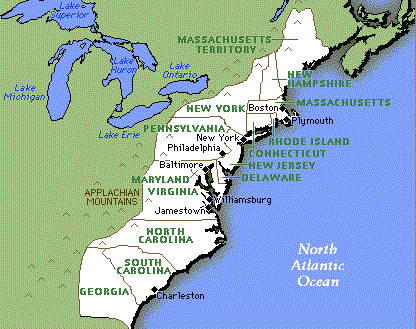American Revolution
|
American Revolution (1775-1783), conflict between 13 British colonies
in North America and their parent country, Great Britain. It was made up
of two related events: the American War of Independence (1775-1783) and
the formation of the American government as laid out by the Constitution
of the United States in 1787. First, the war achieved independence from
Great Britain by the colonies. Second, the newly created United States of
America established a republican form of government, in which power
resided with the people.
The revolution had many causes. Long-term social, economic, and
political changes in the colonies before 1750 provided the basis for an
independent nation with representative political institutions. More
immediately, the French and Indian War (1754-1763) changed the
relationship between the colonies and their mother country. Finally, a
decade of conflicts between the British government and the colonists,
beginning with the Stamp Act crisis in 1765, led to the outbreak of war in
1775 and the Declaration of Independence in 1776. |

13 British colonies in North America |
Once independent, the new state governments implemented republican
constitutions, and a Continental Congress directed the American war effort. Then
in 1781 the rebellious states created a loose union under the Articles of
Confederation. At the end of the war in 1783, Britain recognized its former
colonies as an independent nation. In 1789 the people of the several states
ratified the Constitution that created a stronger central government.
Newspapers in the Revolutionary Period
In 1750 there were 12 newspapers in the American colonies, which then had a
total population of about 1 million. By 1775 the population had increased to 2.5
million, and the number of newspapers had jumped to 48. They were published
weekly, contained only four pages each, and Typically had a circulation of no
more than 400 copies. The papers printed more essays than news and were
distinctly libertarian in tone, anticipating the American Revolution. When the
British Stamp Act of 1765 imposed a heavy tax on paper, the prerevolutionary
press denounced the act and refused to pay the tax. Even though the Stamp Act
was repealed in 1766, it had united many editors and publishers in support of
the cause of independence. The American patriot Samuel Adams, who often edited
the Boston Gazette, organized the Committees of Correspondence, comprising
agents who kept track of events throughout the colonies. In 1776 the patriot
papers carried on their front pages the Declaration of Independence.
During the war, newspapers brought accounts of military developments to an
increasing number of readers, while business generated by the war brought
advertising to the papers. The surviving papers thus emerged from the Revolution
greatly strengthened. This stronger press, however, soon found itself deeply
divided-first, when the Articles of Confederation were ratified and, later, when
the new U.S. Constitution was adopted. On one side of most issues were the
conservative Federalists; on the other side were the agrarian Republicans, or
Democratic-Republicans. On one issue, however, the newspapers of the country
were united: support of the 1st Amendment to the Constitution, adopted in 1791
as part of the Bill of Rights, which declared that "Congress shall make no law Ö
abridging the freedom of speech, or of the press." The amendment also guaranteed
freedom of religion, the right of assembly, and the right to petition Congress.
The 1st Amendment has been under fire many times during the succeeding years,
but it has remained the cornerstone of the free press in the U.S. It has
guaranteed American newspapers as great or greater freedom than the press of any
other nation in the world.
Links
Colonial
America
Colonies
Charters
13
Colonies
Chart: American
Colonies
The Thirteen
Colonies
THE
COLONIAL PERIOD
Common Characteristics
of American Colonies
U.S. History Outlines
& Charts
Early
Colonial Era: Beginnings to 1700
English
Colonial Era: 1700 to 1763
Colonial Cycle
Revolutionary Cycle
Cycles of U.S. History -
Colonial Cycle
An
Outline of American History: TABLE OF CONTENTS
Jewish American Builders of
America Exhibit
ARCHIVING EARLY
AMERICA
US
Quiz page
Causes of The
War
Newspapers
of the Revolution, 1700-1776
The
American Revolution and Marylandís Press
The
History Place - American Revolution
The
American Revolution Index
LIBERTY! The American
Revolution
James Chalmers and
Plain Truth - The Early America Review, Fall 1996
Georgia History-The American
Revolution
American
Revolution
The Thirteen
Colonies
AMERICAN REVOLUTION
PERSUADERS
A Journey Towards
Freedom
American
Revolution Research Links
The
American Revolution
The
Brigade
The
American Revolution Project
founding.com - the User's Guide to the
Declaration of Independence
A Roadmap to the United
States Constitution
Virtual Marching Tour of the
American Revolutionary War
American
History Resources Index
5000 newspapers on
the Net
History
Buff's Home Page


